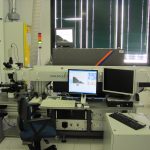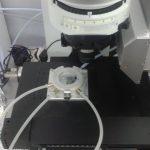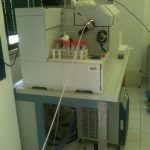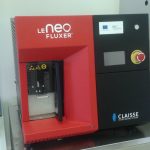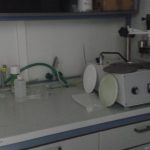The laboratory of laser ablation
Head of the Geochemical Monitoring Functional Unit: Manfredi LONGO
E-mail: manfredi.longo@ingv.it
Laser Ablation Laboratory Referent: Alessandra CORREALE
E-mail: alessandra.correale@ingv.it
E-mail: laboratoriolaser.pa@ingv.it
LA-ICPMS
LA-ICPMS (Laser Ablation-Inductively Coupled Plasma-Mass Spectrometry) is an in situ analysis technique capable of measuring, in a few seconds and with high precision, the content of trace elements in a variety of solid matrices, implying only a small destruction of the sample.
Mode of operation
The laser ablation at high power generates a sublimation of the most superficial portions of the solid sample, producing aerosol which is conveyed in an inert carrier gas stream (in our case helium is used) and conducted in the ICP where the ionization of the sample, through a plasma torch, takes place. The ions of each element, produced by the interaction plasma-ablated material, are conveyed in a mass quadrupole spectrometer where they are separated according to their mass/charge ratio, measured by a detector for the conversion into electrical signal and finally quantified.
Equipment
The instrumentation used for the analyses with LA-ICPMS technique consists of:
• a laser source for the sublimation of the solid under study
• a cell ablation
• a transfer line for transporting the particulate produced
• one ICP mass spectrometer for ionization and masses discrimination
The system is one Compex Pro 102 excimer laser, with ArF source and a wavelength 193 nm (in the UV band) mounted on GeoLas Pro ablation system, provided by Cetac (Fig. 1). This includes an aluminum cell ablation, having a small volume (5cc), closed by a glass, quartz, transparent lid with UV light (Fig. 2). The sample to be analyzed is generally incorporated in EPOFIX resin and polished. The cell characteristics allow to work with high signal/ noise ratios and prevent the contamination of samples with organic material. The cell is connected to one ICP-MS Agilent 7500ce via a Teflon tube having an inner section of 3 mm (Fig. 3). This set-up is used routinely for the measurement of trace elements in crystals and glasses. Finally, the laboratory includes a series of instruments for the microscopic examination of the samples (minerals and rocks) and the preparation of glass disks and mounts for the LA-ICP-MS analyses (Figg. 4 e 5).
Standard and Accuracy
Certified materials (NIST RM 610, 612 614) are used as external standards and measured at the beginning and at the end of each analytical session.
The accuracy of the analyses is controlled by repeated measurements on certified reference materials, in particular USGS BCR-2G (basalt), presenting values between 2-5% for K, Sc, Ti, V, La, Ce, Eu, Th; 6-10 % for Li, Rb, Sr, Cs, Ba, Pr, Nd, Sm, Gd, Dy, Ho, Er, Tm, Yb, Ta, Pb, U, and 11-15% for Zn, Y, Zr, Tb, Lu e Hf.
Data processing
Data are processed using Glitter© program (Van Achterberg et al., 2001) and you need the measurement of a reference element (generally Ca is used) that must be acquired on the sample through another analytical technique. In the phase of data processing, the control of some quality indices of the analysis (as ablation speed, fractionation index etc.) is accurately performed.
Application fields
The versatility, speed and moderate costs of this methodology, when compared to those of technical competitors like EMPA and SIMS, in addition to the high number of analyzable elements, have led to an extensive use in various disciplines such as:
• Geological and environmental sciences
• Biological science
• Forensic science
• Cultural heritage
List of the present instrumentation:
• Laser ad eccimeri con microscopio petrografico integrato, GeoLas Pro
• Excimer laser with integrated petrographic microscope, GeoLas Pro;
• ICP-MS Agilent 7500;
• Fusion instrument, Claisse Leneo FluxerTM for glass disks preparation and mineralization of solid samples (Fig.4);
• Polisher, LS2 Remet and material for the preparation and polishing of samples embedded in resin (Figure 5);
• Petrographic microscope
References:
-Van Achterbergh, E., Ryan, C.G., Jackson, S.E. and Griffin, W.L., 2001, Data reduction software for LA-ICP-MS: appendix; In Sylvester, P.J. (ed.), Laser Ablation –ICP-Mass Spectrometry in the Earth Sciences: Principles and Applications, Mineralogical Association of Canada Short Course Series, Ottawa, Ontario, Canada, v. 29, pp. 239-243.











